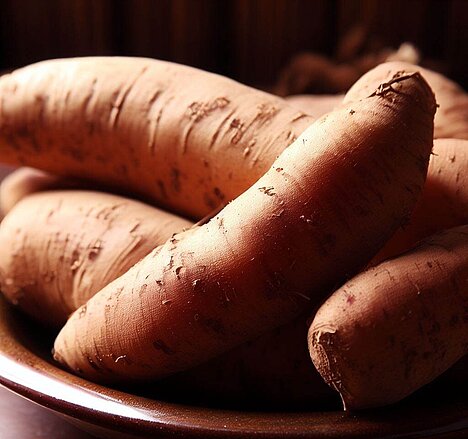Light root

What is light root?
Light root is a perennial plant that belongs to the composite family. It grows in the Andes and has been used there for centuries as a food and medicinal plant. The plant has large, green leaves and small, yellow flowers. The edible parts are the tubers that grow underground. They have a brown skin and white or yellow flesh. The tubers taste sweet and are reminiscent of pears or melons.
What are the benefits of light root for dogs?
Light root can have some health benefits for dogs, especially those that suffer from digestive problems. The fructooligosaccharides in the tubers are prebiotic, meaning they promote the growth of good bacteria in the gut. This can lead to better nutrient absorption, a stronger immune system and less susceptibility to diarrhea or constipation. Lightroot can also help to regulate blood sugar levels as the fructooligosaccharides are not absorbed into the bloodstream as quickly as other sugars. This can be beneficial for dogs with diabetes or obesity. Lightroot is also rich in potassium, calcium, iron and vitamin C, which contributes to a good supply of these important nutrients.
What are the disadvantages of light root for dogs?
Lightroot is not suitable for all dogs. Some dogs may have an allergic reaction to the plant or experience stomach problems if they eat too much of it. Therefore, you should always be careful when feeding your dog something new and observe the reaction. You should also make sure that your dog does not eat too much light root, as this can lead to an overdose of fructooligosaccharides. This can lead to flatulence, diarrhea or vomiting. Lightroot should therefore only be fed in moderation and not as a staple food.
How do you feed light root to dogs?
Light root can be fed to dogs raw or cooked. However, the skin should always be removed as it is indigestible and can lead to intestinal obstruction. The tubers can be cut into small pieces or grated and added to food as a snack or side dish. However, you should always make sure that the dog drinks enough water, as light root is very rich in water and increases the need for fluids. You should also not cover more than 10% of the dog's daily calorie requirement with light root to ensure a balanced diet.
Lightroot is an interesting ingredient for dogs that can have some health benefits, especially for gut health. However, you should always be careful when feeding your dog something new and limit the amount to avoid side effects.
If you notice any signs of hypersensitivity or poisoning in your dog, you should see your vet immediately. We are not a substitute for a vet, but we try to be as accurate as possible. Every dog reacts differently and we recommend you get a second opinion or consult your vet if in doubt.
Stay healthy and take good care of your four-legged friend!😊
Similar to Light root
Yams (Dioscorea) are a genus of climbing plants that form starchy tubers. They belong to the yam family (Dioscoreaceae) and have nothing to do with sweet potatoes, with which they are often...
Yams root is a tropical plant that belongs to the bindweed family. It has long, climbing stems and heart-shaped leaves. The edible parts are the thickened roots, which can have different shapes,...
Potatoes consist of 78% water and 18% carbohydrates. Carbohydrates are not essential for dogs, but can be a good source of energy, especially for active or sporty dogs. Carbohydrates are broken down...
Sweet potatoes are not potatoes, but tubers that belong to the bindweed family. They originally come from South America and are now grown in many tropical and subtropical regions. Sweet potatoes...



